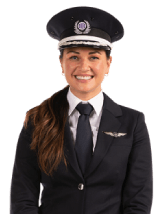Gather your documents
Everyone leaving the country must have a valid passport, and that includes your wee baby. Additionally, you may be required to provide supporting documentation such as a birth certificate, custody documents, a divorce certificate or a consent letter from your child's other parent if you're travelling without them.
Speak to your travel consultant and review Canada's guidelines for travelling with infants and children before you fly.
Get a free ticket
Typically, domestic flights on major carriers will allow your little rascal to fly free of charge on your lap. Most international flights will charge about 10% of an adult's fare if you're sharing your seat with a little one. Ask your travel consultant if you can take advantage of a free fare based on your child's age and your itinerary.
If you realize (perhaps after your first time flying with them) that your kiddo would do better in their own seat, you’ll need to pay for a child's fare sooner than you think. In this case, you'll also need to be prepared with an approved restraining device for their safety.
Sit together
It's not a given that your assigned seats will be next to each other, so it's important to ask your agent to arrange this for you while you book! Many airlines will waive their seat selection fee for passengers flying with infants and children.
Give yourself plenty of time
Frequent flyer families will have a chuckle at this, but it might not be so obvious for first-time travelling parents. The amount of time you imagine you'll need to make your way through the airport probably isn't enough.
Now, don't get us wrong, advances in technology have made the airport experience really efficient over the years. But it's still much better to account for extra potty breaks, tired toddler feet, meltdowns, snack requests, pausing to watch planes take off and more potty breaks.
Many of our Flightie parents recommend preparing your children a few days before your trip so they know what to expect. (Hint: that line through international customs is usually when things fall apart).
Take advantage of extra carry-on items
While this varies by airline and flight route, you'll typically have one carry-on item, one personal item and an extra item for your infant (such as a diaper bag or breast pump) per ticket. This means if your little one has their own seat, you'll both be entitled to those carry-on items, so long as you don't need assistance with stowing them all away.
Double-check your airline's carry-on size restrictions online or with your travel consultant so you have no surprises.
Tips for breastfeeding or bottle-feeding
Breastmilk, baby formula and baby food are exempt from the usual 100ml maximum allowed through airport security. That being said, you won't have access to a refrigerator on the plane, so ice packs or gel packs are also permitted to keep your baby's food at a safe temperature.
Many domestic and international airports have dedicated breastfeeding areas. Ask your travel consultant for an airport map in advance and save it on your phone.
Understand face mask policies
Until we see the end of the COVID-19 pandemic, face masks are expected to be a regular part of the travel experience. Each airline, airport and country may have a different age policy regarding face masks.
If your child is six years old or younger, we highly recommend speaking to your travel consultant about whether your little one is required to wear a face mask at different points of your journey.
Find more information about COVID-19 health & safety policies in our traveller resource hub.
Know the minimum age for flying
Depending on your destination, the minimum age to fly with your baby is usually one week. With that being said, you'll need to wait at least long enough to receive your baby's passport. The Canadian government is experiencing some processing delays due to COVID-19, so we recommend waiting for your child's passport before booking.
Check for updates on this website.
Flying with two infants
An adult passenger cannot be responsible for more than one infant. If you're travelling with twins, you'll need two people at least 16 years of age or older to board.
To pre-board or not pre-board?
Priority boarding is given to people travelling with babies and young children in order to give caretakers enough time to get settled into their seats.
Some parents find that it's actually easier for them to wait in the terminal a little longer, especially if their child needs some de-escalating at the moment. We recommend going for the priority boarding experience first and if it doesn't work for your family, you'll know better for next time.
Choose toys wisely
Many of our Flightie parents can attest that more toys aren't necessarily better. It's far better to have your child pick out just one or two favourite toys for the flight than to find yourself hunting the aisles for five different lost teddy bears.
So how do you keep your cuties entertained? Firstly, if there's ever a time to relax your screen-time rules, it's now! But durable board books and airline kid's entertainment amenities are also a lifesaver.
Consider an evening flight
Our Flightie parents highly recommend evening or overnight flights for any journey longer than five hours. Planning around your child's current sleep schedule is the best way to all but ensure a peaceful flight. We also recommend bringing along a couple of pillows for a comfortable snooze.
Bring children's Gravol
Even adults can feel a little queasy while flying; it's easy to understand why young ones have tummy troubles too. Talk to your doctor or pharmacist about a children's Gravol or similar product to bring along in case of motion sickness. If your child is old enough, you can also bring some mints or chewing gum for their ears.
Stopover? Invest in airport lounge access
For a stopover that’s a few hours, it is worth paying for a lounge pass. You’ll have access to hot and cold meals, drinks and some have quiet areas for nursing, with much comfier seats you’ll find in the general airport.
The more clothes, the better
We suggest you be prepared with a full days’ worth of diapers, wipes and spare clothes for both you and your little one.
Opt for Premium Economy whenever possible
Premium Economy can be a game-changer in terms of space, attentive service and extra snacks. If it works with your budget, go for it!
Be a good neighbour
Making nice with those around you helps circumnavigate any raised eyebrows when your little one throws their toys (or tantrums.) You might even get lucky with friendly aisle-mates who play peekaboo with your toddler, which is a very welcome distraction.
Walking up and down the plane with your child is a great way to ease tension (and tight muscles). But keep in mind not to disturb passengers who might be working in business class.
Pack snacks!
There's no guarantee that meal service will line up with your kids' eating schedule (or yours), so it really helps to have your own healthy snacks ready to go. Think sliced veggies, dried fruit, and granola bars.
Get a smart travel bag (like JetKids or Trunki)
Encourage kids to pack their own carry-on. Many of our Flighties use a rideable travel bag like JetKids or Trunki, which makes travelling through the airport with a toddler fun, fast and easy! They can steer it themselves, or you can pull them along when they are tired. The JetKids extra padding turns the airplane seat into a cozy bed for them to sleep.
Arrange for an early check-in
In case you arrive long before check-in, pay for the night prior or arrange for an early check-in so you can get to your hotel room right away for a much-needed nap.





















